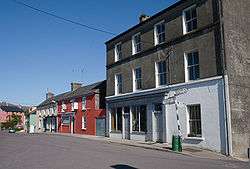Goleen
| Goleen An Góilín | |
|---|---|
| Village | |
|
Main Street of Goleen | |
 Goleen Location in Ireland | |
| Coordinates: 51°29′42″N 09°42′41″W / 51.49500°N 9.71139°WCoordinates: 51°29′42″N 09°42′41″W / 51.49500°N 9.71139°W | |
| Country | Ireland |
| Province | Munster |
| County | County Cork |
| Time zone | WET (UTC+0) |
| • Summer (DST) | IST (WEST) (UTC-1) |
Goleen (Irish: An Góilín) is a small rural village in County Cork on the south-western tip of Ireland. Farming and construction work are the main occupations of the local people. Many are involved with some aspect of the tourist business, looking after some of the many holiday homes which surround the village. The village has four pubs, four shops, and a petrol station.

Goleen is located towards the south-western end of the Mizen Peninsula, in West Cork. The land surrounding the village is of poor quality for farming, being hilly and rocky with limited soil cover. The village has a large Roman Catholic church; there is a smaller Church of Ireland church situated just outside the village but this has now been deconsecrated and is the site for a sail-maker.
Mizen Head, at the southern tip of the Mizen peninsula, about five miles from the village, is often claimed to be the most southerly point on the island of Ireland, but is in fact the country's most southwesterly point. The distinction of being Ireland's most southerly point belongs to nearby Brow Head, from where Guglielmo Marconi experimented with transatlantic radio signals at the beginning of the 20th century.
The town also boasts a community pitch on which locals play Gaelic football and soccer. In the sports hall beside the pitch, is a table tennis club which has 26 members, some of which have played internationally.
In 1852, shortly after the famine, the parish priest John Foley started to build a new parish church with the help of donations by Irish emigrants.[1] The church was erected in the Neo-Gothic style with a cruciform aisleless ground plan, four bays, and a triplet window in the chancel behind the high altar. Bishop William Delaney of the diocese of Cork consecrated the church on 11 October 1854.[2]
Bus
Bus Éireann run the 237 bus service from Cork City to Goleen.
Air
The nearest airport is Cork Airport.
References
- ↑ Hickey, Patrick (1995). "The Famine in the Skibbereen Union (1845–51)". In Póirtéir, Cathal. The Great Irish Famine. Cork: Mercier Press. pp. 200–201. ISBN 1-85635-111-4.
- ↑ "Goleen Parish History". Diocese of Cork and Ross. Retrieved 18 July 2010.
